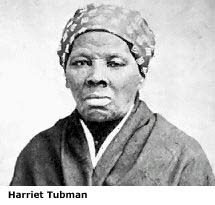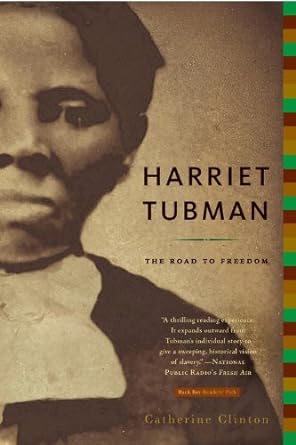Harriet Tubman
 During the nineteenth century, abolitionists in Boston and throughout the North used the personal experiences of former slaves to expose the brutalities of American slavery. One of the most famous former slaves, who became a leader in the struggle against racism and brutality, was Harriet Tubman. A conductor on the underground railroad, Harriet Tubman led over 200 slaves to freedom; her bravery, determination, and vigilance symbolize the significance of African-American resistance in the struggle for American equality.
During the nineteenth century, abolitionists in Boston and throughout the North used the personal experiences of former slaves to expose the brutalities of American slavery. One of the most famous former slaves, who became a leader in the struggle against racism and brutality, was Harriet Tubman. A conductor on the underground railroad, Harriet Tubman led over 200 slaves to freedom; her bravery, determination, and vigilance symbolize the significance of African-American resistance in the struggle for American equality.
Harriet Ross was born a slave in Dorchester County on the eastern coast of Maryland sometime around 1821. One of the most dramatic moments of her life occurred when she was dealt a nearly fatal blow to the head by an overseer who had been aiming for another slave. Although the young Harriet eventually recovered from the injury, she was forever plagued by frequent narcoleptic seizures. She believed that, through these seizures, she was an instrument of God in the struggle for African-American emancipation. By 1844, Harriet married a free African American named John Tubman. He did not share her passionate desire for freedom, however, and when she managed to escape to the north in 1849, he did not go with her. When she returned two months later to rescue him, he had taken another wife. Undaunted, Harriet continued to forge a personal, spiritual, and militant crusade against slavery, and did not marry again until 1869.
Harriet's first stop in the north was Philadelphia where she worked as a domestic and came in contact with many members of the city's abolitionist movement. She saved the money earned from her domestic work to finance her trips South to rescue slaves. Between 1849 and 1860, Harriet made somewhere between 11 and 20 trips, and rescued over 200 slaves. Unapologetically militant, Harriet Tubman used a variety of tactics to rescue fugitives and outwit slaveowners. She disguised herself as an insane, homeless Black man, and as a mentally impaired free woman; she and her cargo hid in trees, plodded through mud, and concealed themselves from bounty hunters. She carried a paregoric with her to calm crying babies, and a pistol to discourage fugitives too frightened and tired to continue the journey. In 1850, after the passage of the Fugitive Slave Law, Harriet moved to Saint Catherines, Ontario, just beyond Niagara Falls, a frequent destination for fugitive slaves. Despite the law, however, she continued to make the journey south to rescue fugitive slaves. Called "Moses" by abolitionists and fugitives alike, Harriet Tubman was seen as such a threatening force that Maryland planters offered a $40,000 for her capture.
Tubman's faith played a significant role in shaping her character, guiding her actions, and providing her with strength and resilience in the face of adversity.
Tubman often spoke about her strong spiritual connection and her belief in God's guidance and protection. She viewed her actions in helping enslaved individuals escape to freedom through the Underground Railroad as part of God's will and divine mission. Tubman's faith empowered her to undertake perilous journeys and risk her own safety to lead enslaved people to freedom, trusting in God's providence to guide and protect her along the way.
Throughout her life, Tubman continued to draw upon her religious beliefs for comfort, courage, and determination. She saw herself as an instrument of God's justice and mercy, dedicated to fighting against slavery and injustice wherever she encountered it.



